Another day, another chore in the pond
Last Sunday was the day I was supposed to install the new waterfall. Well, you know how that goes ... life gets in the way when you're busy making plans ... and it didn't get done - again!
There were other pond maintenance tasks to be done first and by the time that was over, I was hot, bothered, semi-wet and didn't feel like getting into the whole waterfall thing. So until next weekend ...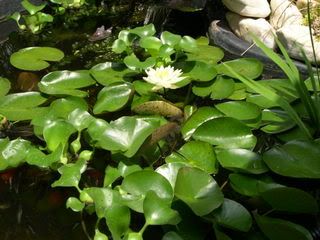
First off, the bottom of the pond was covered with "muck" again. Muck is the term coined to describe the various dirt, plant and fish waste that accumulates on the bottom of a backyard pond. I had successfully vacuumed the bottom of the pond about 2 1/2 weeks ago, and it was definitely time to do it again. Nothing is every an easy fix ... and I guess I'll be vacuuming the pond for the rest of the summer.
The Muck-Vac (www.muckvacdirect.com), however, makes this task is tolerable as possible. It does a great job, I didn't get nearly as soaked this time and even the fish are starting to get used to the plastic stranger in their pond In order to properly vacuum the bottom, it's best to remove the plants. The bottom of my pond is home to a few waterlillies that are having an excellent blooming season. So I thought I'd take a shot of how the waterlilly plant looks outside its natural habitat. Pretty big huh?
In order to properly vacuum the bottom, it's best to remove the plants. The bottom of my pond is home to a few waterlillies that are having an excellent blooming season. So I thought I'd take a shot of how the waterlilly plant looks outside its natural habitat. Pretty big huh? 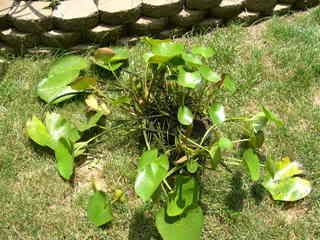
Anyway, it doesn't hurt the plant to remove it temporarily, just don't let it dry out. This is also a great opportunity to trim back the leaves, lest they overtake your pond. The waterlilly pads provide shade, which in turn, lowers the temp in your pond, and is also an excellent place for your fish to hide from any predators (like herrings, for instance). It also provides a place for them to hide from you, so that's why I periodically trim them back. I like to see the fish occasionally, no matter how much they don't like being watched.
Lillypads also help keep algae from overtaking your pond, because they don't let as much sunlight in. If you don't have any waterlillies, you might want to invest. I know I got some of mine at Lowe's for as little as $5. They can winter-over in your pond from year to year and don't require a lot of care.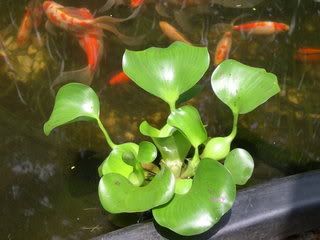
Another good plant that I use in the pond is the water hyacinth, pictured here. They can be bought at a pond store for as little as 3 for $10. Believe me, ONE is all you'll need. This plant is very invasive, and is actually outlawed in natural ponds in many states. A floating plant that rests on top of the water, if left on its own, will continually reproduce and take over the entire surface of a pond, choking out all plant, as well, as fish life. It does have a beautiful bloom though. A large lavendar bloom composed of many smaller flowers, resembling the bloom of a hyacinth, hence the name. However, the bloom only lasts one day, so enjoy it while you can. Once it blooms, the hyacinth plant can be thrown away, as one bloom is all it gets. Yes, it makes me feel bad to just throw away any plant, but at least every two weeks, I have to toss a bunch of these plants, or the pond would be doomed.
Another great pond plant I love is the Canna. I'm sure you've seen Canna before, they are large tropical and subtropical perennial herbs with a rhizomatous rootstock. The broad, flat, alternate leaves, that are such a feature of this plant, grow out of a stem in a long narrow roll and then unfurl. The leaves are typically solid green but some cultivars have brownish, maroon, or even variegated leaves.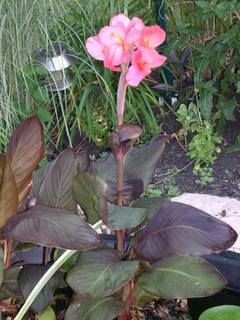
The flowers are typically red, orange, or yellow or any combination of those colours. Although gardeners enjoy these odd flowers, nature really intended them to attract bees and hummingbirds for pollination (Wikipedia also states that they can attract bats, thank goodness I haven't noticed that in my garden).
Canna grow from swollen underground stems, correctly known as rhizomes, which store starch, and this is the main attraction of the plant to agriculture, having the largest starch particles of all plant life. Canna are not zoned for our area, so if you want to keep them as a perennial, they can to be dug up (or in my case removed from the pond) and stored indoors in a cool, dry place (the basement is good) until the following spring.
But check out this bloom ... that makes all the trouble worth it.
There were other pond maintenance tasks to be done first and by the time that was over, I was hot, bothered, semi-wet and didn't feel like getting into the whole waterfall thing. So until next weekend ...

First off, the bottom of the pond was covered with "muck" again. Muck is the term coined to describe the various dirt, plant and fish waste that accumulates on the bottom of a backyard pond. I had successfully vacuumed the bottom of the pond about 2 1/2 weeks ago, and it was definitely time to do it again. Nothing is every an easy fix ... and I guess I'll be vacuuming the pond for the rest of the summer.
The Muck-Vac (www.muckvacdirect.com), however, makes this task is tolerable as possible. It does a great job, I didn't get nearly as soaked this time and even the fish are starting to get used to the plastic stranger in their pond
 In order to properly vacuum the bottom, it's best to remove the plants. The bottom of my pond is home to a few waterlillies that are having an excellent blooming season. So I thought I'd take a shot of how the waterlilly plant looks outside its natural habitat. Pretty big huh?
In order to properly vacuum the bottom, it's best to remove the plants. The bottom of my pond is home to a few waterlillies that are having an excellent blooming season. So I thought I'd take a shot of how the waterlilly plant looks outside its natural habitat. Pretty big huh? 
Anyway, it doesn't hurt the plant to remove it temporarily, just don't let it dry out. This is also a great opportunity to trim back the leaves, lest they overtake your pond. The waterlilly pads provide shade, which in turn, lowers the temp in your pond, and is also an excellent place for your fish to hide from any predators (like herrings, for instance). It also provides a place for them to hide from you, so that's why I periodically trim them back. I like to see the fish occasionally, no matter how much they don't like being watched.
Lillypads also help keep algae from overtaking your pond, because they don't let as much sunlight in. If you don't have any waterlillies, you might want to invest. I know I got some of mine at Lowe's for as little as $5. They can winter-over in your pond from year to year and don't require a lot of care.

Another good plant that I use in the pond is the water hyacinth, pictured here. They can be bought at a pond store for as little as 3 for $10. Believe me, ONE is all you'll need. This plant is very invasive, and is actually outlawed in natural ponds in many states. A floating plant that rests on top of the water, if left on its own, will continually reproduce and take over the entire surface of a pond, choking out all plant, as well, as fish life. It does have a beautiful bloom though. A large lavendar bloom composed of many smaller flowers, resembling the bloom of a hyacinth, hence the name. However, the bloom only lasts one day, so enjoy it while you can. Once it blooms, the hyacinth plant can be thrown away, as one bloom is all it gets. Yes, it makes me feel bad to just throw away any plant, but at least every two weeks, I have to toss a bunch of these plants, or the pond would be doomed.
Another great pond plant I love is the Canna. I'm sure you've seen Canna before, they are large tropical and subtropical perennial herbs with a rhizomatous rootstock. The broad, flat, alternate leaves, that are such a feature of this plant, grow out of a stem in a long narrow roll and then unfurl. The leaves are typically solid green but some cultivars have brownish, maroon, or even variegated leaves.

The flowers are typically red, orange, or yellow or any combination of those colours. Although gardeners enjoy these odd flowers, nature really intended them to attract bees and hummingbirds for pollination (Wikipedia also states that they can attract bats, thank goodness I haven't noticed that in my garden).
Canna grow from swollen underground stems, correctly known as rhizomes, which store starch, and this is the main attraction of the plant to agriculture, having the largest starch particles of all plant life. Canna are not zoned for our area, so if you want to keep them as a perennial, they can to be dug up (or in my case removed from the pond) and stored indoors in a cool, dry place (the basement is good) until the following spring.
But check out this bloom ... that makes all the trouble worth it.
Labels: canna, Muck-Vac, water gardening, water hyacinth, waterlillies
 RSS
RSS
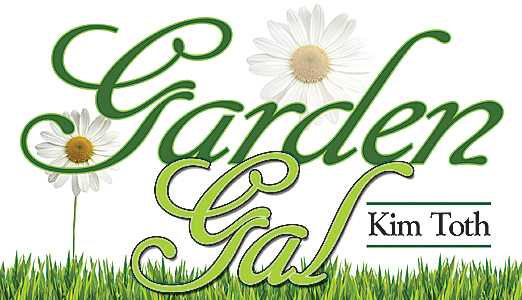


0 Comments:
Post a Comment
Links to this post:
Create a Link
<< Home